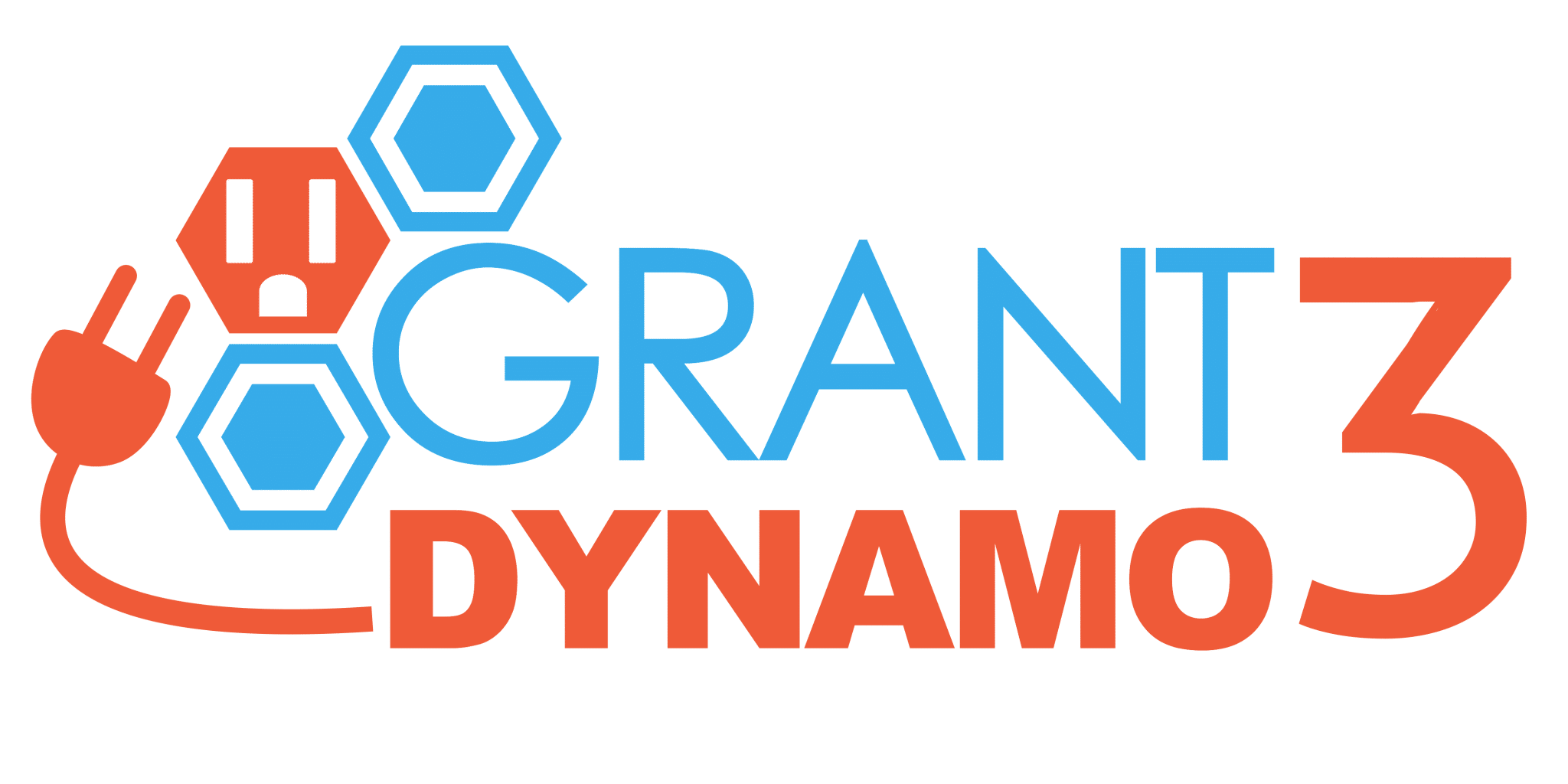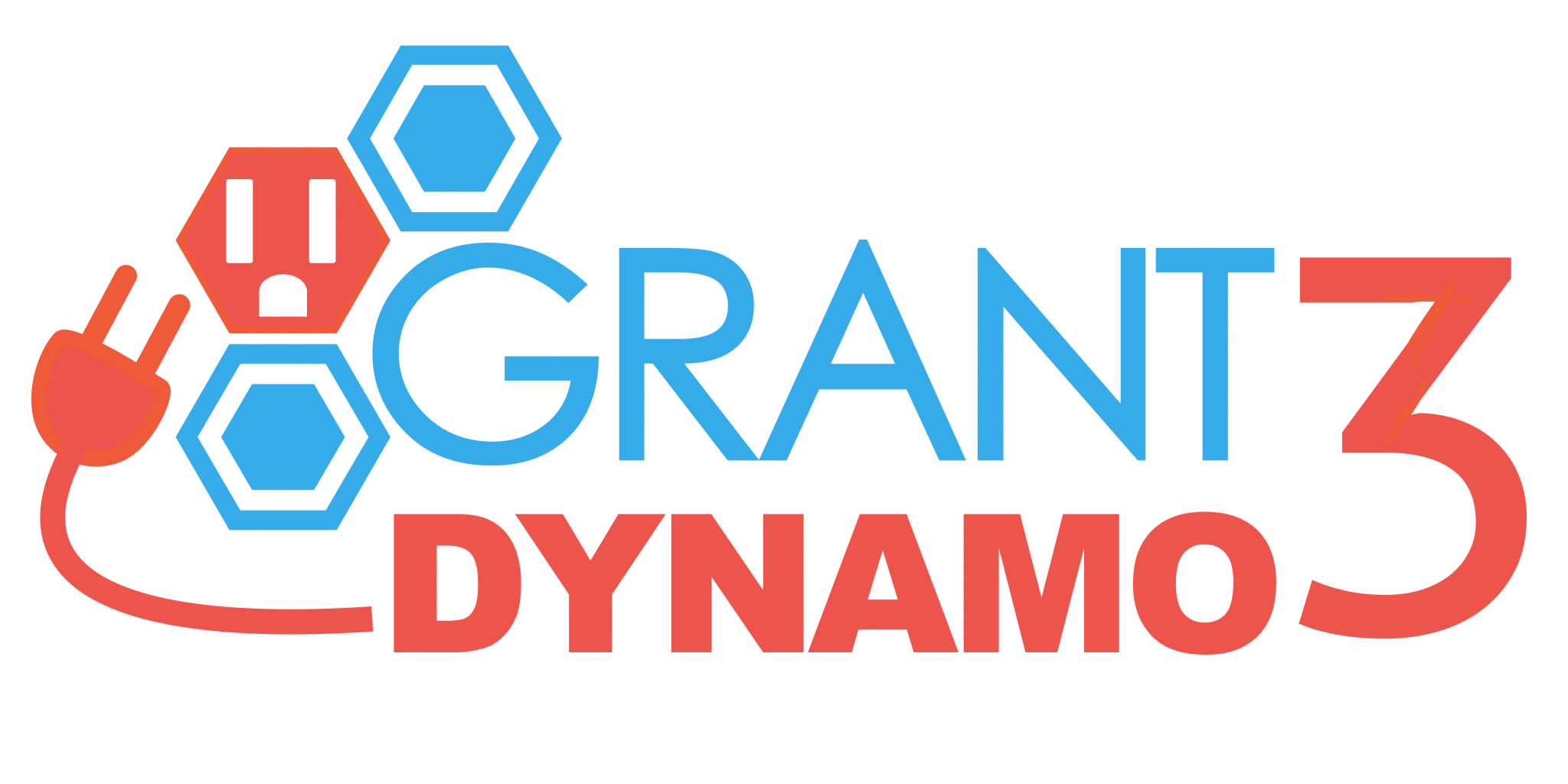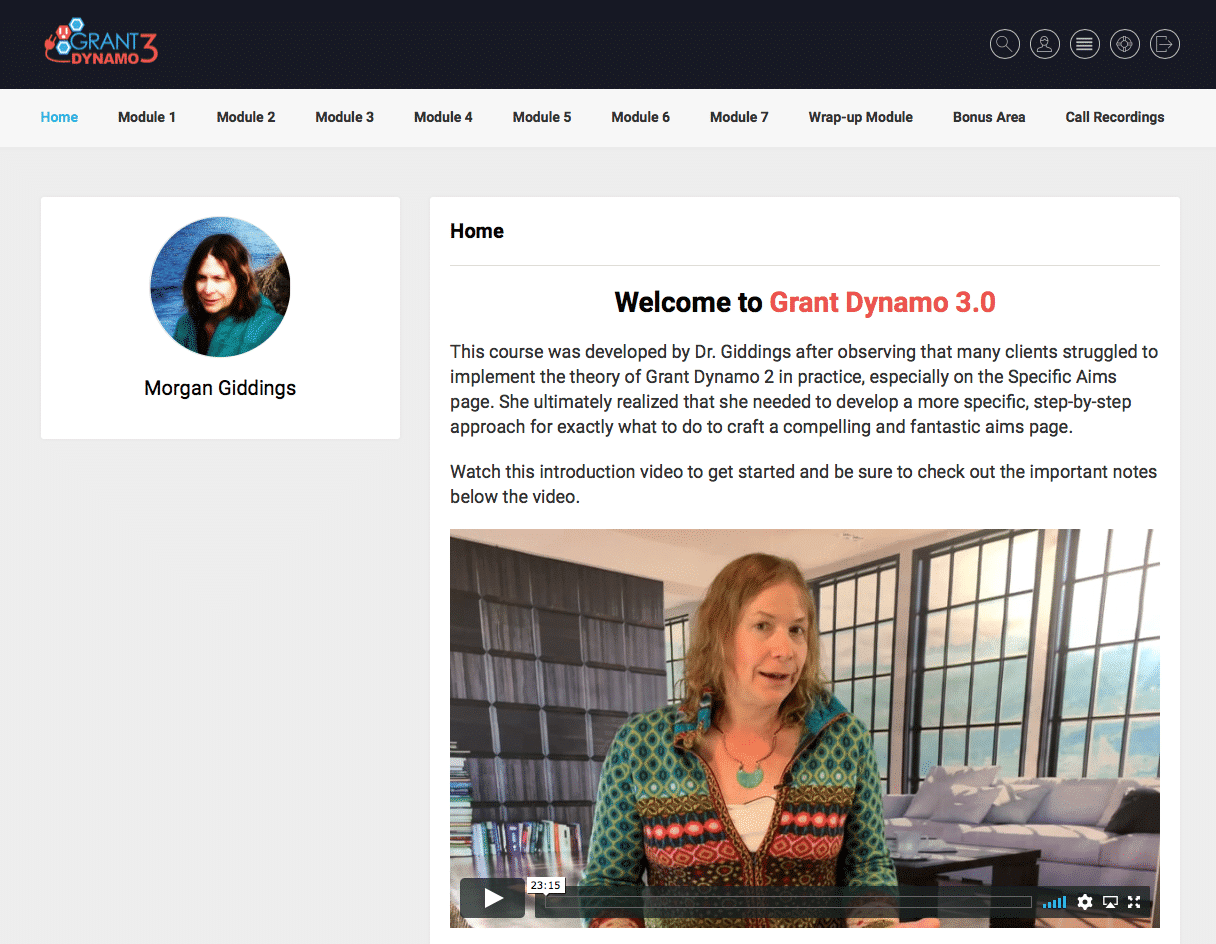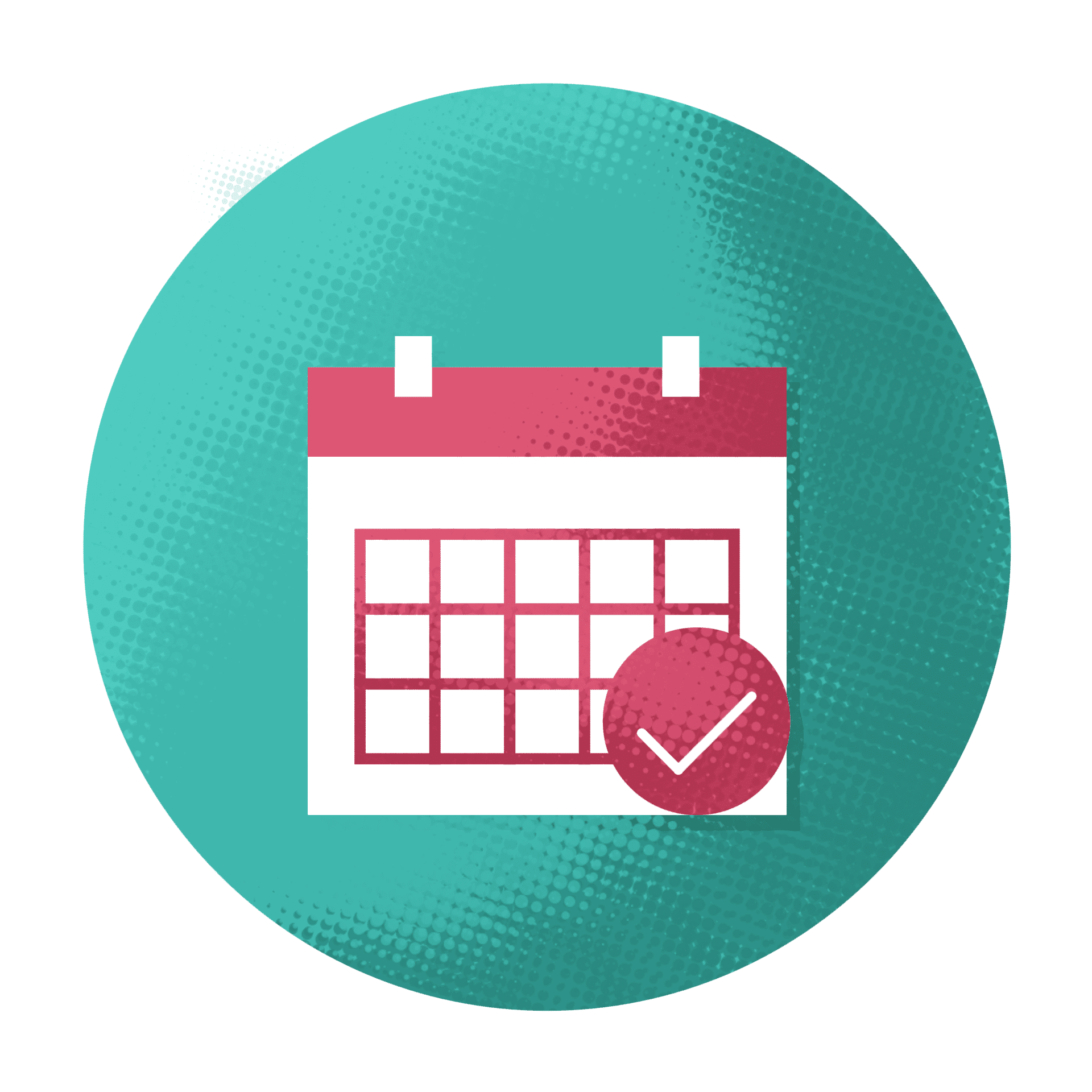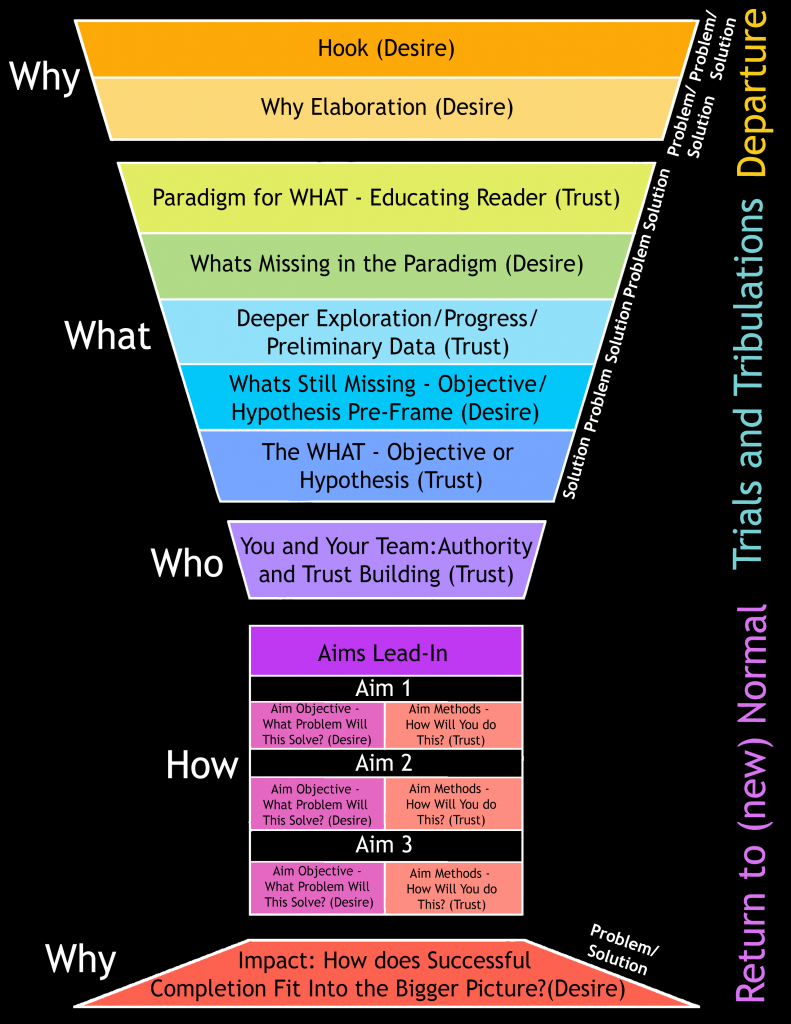The Quick and Dirty Story
If your goal is to develop the deep skill of persuasive grant writing - so that you can spend less time writing rejected proposals, enjoy the writing process more, and be more efficient, then consider this: do you have time to attend most or all of the two day live workshop? Or would you prefer to take your time, go at your own pace, and and skip the line to get ongoing access to the Grant Dynamo 3 course - plus bonuses - at a the biggest tuition discount you’ll see over the upcoming year? If you choose this option, you can take your time, go at your own pace, and repeat the lessons as many times as you like while you write your proposals.
You can take advantage of this immediately using the registration link on the right, or read below for more information.
Grant Dynamo 3 Level I Course - including recordings, templates, examples, and bonuses
One of the most important questions about your chances of research grant funding:
Does your proposal keep your reviewers reading, or put them to sleep?
Or worse: make them want to burn it in frustration?
The fact is, most research grant proposals are boring at best, and extremely frustrating at worst. Even if you have fantastic research and a strong track record, most reviewers won't be able to look beyond the boredom, irritation, and frustration they may experience reading your proposal. If so, your review scores (e.g. NIH Impact scores) will suffer. Can you afford that kind of negative impact on your grant scores in an environment where pay lines can be as challenging as 1 in 12 funded (8%)?
If you're not a fan of wasting your time on needless rejection, then perhaps it's time to learn the deeper triggers for the frustration and boredom - and most importantly, how to avoid them. That's where the Grant Story comes in.
You want your reviewer to be engaged and excited about your work - enough to advocate for funding?
You need a compelling Grant Story
From the desk of Morgan Giddings, PhD
If you don't have a compelling "story" (constructed appropriately for a scientific/research audience), then it is much less likely you will get the attention and interest of reviewers needed for their support.
Good science/research is not enough - many of your colleagues are doing great (or at least good) research too. So if your proposal is in a stack of proposals with one-in-eight to one-in-twelve chances of funding (typical pay lines at NIH), it needs to be the one out of eight or more that your reviewer picks to advocate for.
If you rely solely on the idea that your science/research will "sell itself", you are relying on a lottery.
It always surprises me that so many researchers seem to think grant funding is indeed a lottery - that is, until I consider the preceding sentence.
Many researchers rely on the "goodness" of their science/research to sell itself. Or - worse - they rely on outdated concepts of presentation that use ineffective strategies like overwhelming the reader with facts or authority.
While facts and data are very important in research proposals, they must be put into an appropriate context to connect powerfully with your readers.
And that is where the power of story comes in: it provides the framework in which we present our facts and data in just the right order and context to yield the highest potential interest.
Once you develop the skill of weaving your facts, data, and projects into clear and compelling story, you'll likely find that your readers are more engaged, interested, and ready to support you.
Yet it is a skill that few researchers possess. We aren't trained in story, we're trained in how to do research.
They are two entirely different animals, yet developing the skill of effective story creation can take just as long as developing effective research skills.
That's especially true if you approach it with trial-and-error, trying to use (often) obtuse reviewer feedback to figure out what was wrong with your story, correcting it, and waiting another 4-6 months for feedback.
I've worked with clients for over a decade on developing the skill of more effective proposal writing - i.e. telling an effective story.
Through that work, I identified the specific elements and order in which they're presented that defines some of the most compelling grant stories I've seen - ones that resonated with reviewers and gained funding.
The question for most researchers who don't have a PhD in "telling effective story about their research" is this: how do you get the training and skills you need to craft your grant story more effectively, so that your reviewer has a better experience with your proposal and is more likely to support it for funding?
That's Why We Created the Grant Dynamo 3 Course
The Grant Dynamo 3 course is the culmination of a decade of work training researchers in the US and across the globe how to write more compelling stories. Grant Dynamo 3 is the most advanced course we've taught, distilling the process down to a step-by-step approach you can apply to your own proposals now and in the future.
It presents the framework of the "Grant Story Funnel," and walks you through it step-by-step. At each step, you're given details and examples about the function that part of the story has, and how to do it effectively. You're given exercises (with worksheets) you can use each time you start a new proposal, to walk you step by step through the process, until you master it.
My team and I have applied the Grant Story Funnel to many client proposals to analyze what is working - and not working - and it brings rapid clarity to the process I have not seen from any other method available.
So if you want that kind of clarity about your own proposals - to maximize your efficiency and productivity in gaining the funding you need to keep your research going - then the Grant Dynamo 3 may be the golden ticket. And the good news is that it's available at the lowest tuition of any grant writing course I've created since 2012. I want to make it as accessible to the widest range of people possible.
Important note: The Grant Dynamo 3 (Level I) focuses exclusively on the Specific Aims page (or equivalent front page), and does not cover other parts of the proposal in any detail. The story you develop in this course can be used for the rest of your proposal, and we give you detailed instructions on that in the Grant Dynamo 3 - Level 2. Purchase both together today and save $245 off purchasing separately.
I am truly thrilled to share the Grant Story Funnel with you, so that you can have more efficiency, less rejection, and help me in my goal of making the whole research endeavor to be a more efficient and fun place to work in.
The Grant Dynamo 3 To Maximize Your Grant Writing Efficacy
I created the Grant Dynamo 3 online course to facilitate your ongoing, long-term practice for deep skills development.
It consists of Eight Core Modules that walk you through the Grant Story Funnel step-by-step, showing you how to create a compelling, persuasive grant story.
It is designed to be used AS YOU WRITE your next proposal. At every step, I give you examples of how to put powerful words to your research from funded proposals, substantially accelerating your learning curve.
A few key things you will learn ...
What you get in Grant Dynamo 3 - Level 1
You get ongoing access to all the class materials for a minimum of two years.
Grant Dynamo 3 - Level 1 is eight Modules of Course Training Materials, to take you Step-by-Step through crafting your Grant Story Funnel.
The content is provided via HD videos and you will have ongoing access (minimum of two years).
You'll be able to pause the lessons to do the exercises, that will substantially strengthen your implementation of the material.
We will also provide you with downloadable audio versions to take on the go with you when commuting, doing housework or whatever.
In your member's area, you will also get access to all the slides, worksheets, and proposal examples for downloading whenever you need them for a proposal you're working on.
You'll get immediate access to Modules 1 and 2, then weekly after that the additional modules will unlock. This gives you time to do the worksheets and apply them to your own writing efforts.
You get bonus content to supplement your learning
It may seem like ten plus hours of training is enough to cover it all, but as with any deeper skill, that's not enough. There are aspects and nuances I just didn't have time to cover in the primary training, but I wanted to include these resources for you. For example:
Take your time, iterate, and build lasting skills in effective proposal writing
Go Deep, Build Skills: By registering for Grant Dynamo 3, you can take your time to deeply learn the approaches.
Student/Post-doc discount: For verified students and postdocs, we offer a further discounted version that does not include the Specific Aims review. You can just email us a few details that we'll verify to get you started with the discount.
Level Up! Add Grant Dynamo 3 - Level 2 at a Substantial Discount: Invest now for the future and add the second level of the course. Level 1 gets you started with the most critical portion. Level 2 takes these ideas into the rest of the proposal with specific instructions on the Significance, Innovation, Approach and other sections - as well as core exercises to help you get clarity on your research message.
If you choose to add on Grant Dynamo 3 Level 2 to your Level 1 registration TODAY, you will save $100 vs. purchasing both separately. With the combination of the two classes, you will have every tool at your disposal for mastering the writing of strong, compelling proposals that are likely to engage and connect with your readers.
The Grant Dynamo 3 Level I Course Modules Overview
Based on over 10 years of working with clients, we developed a step-by-step approach to building a stellar "front page" (Specific Aims, Project Summary, etc) for your proposal using the proprietary Grant Story Funnel. The course has eight modules that walk you through each step of developing an enthusiasm-generating Grant Story Funnel, using examples from eleven funded proposals to NIH, NSF, and DOD.
Module 1: Alignment Between You and Your Reviewer
Your reviewer's state of mind, and how the subtleties of what you write may impact that profoundly. Using appropriate research to steer the response in your favor.
Module 2: Unlock Reviewer Emotion With A Powerful Story
If you want a strong positive response, your proposal needs to be a story. This module shows you how to do that, breaking it down into the key steps you can follow to increase your chances of enthusiasm, every time.
Module 3: Engage With a Strong WHY
The foundational step of your story is a strong "Why The Reader Should Care" - but most people end up using generic, boring, boilerplate - which is the opposite of what you should do. This module breaks down for you exactly what to do, with a plethora of examples to illustrate.
Module 4: Setting The Stage for your WHAT (hypothesis/objective)
It's easy to rush immediately from the "WHY" into your objective or hypothesis - before the reader is ready for it. This leads to defensive responses (lower scores). It's essential to prime the reviewer so they are excited and ready for your WHAT. This module shows you how to do that, and the mistakes to avoid -- using funded examples.
Module 5: Your WHAT - A Compelling Objective/Hypothesis
You may be clear on WHAT you are proposing to do, but conveying that to your reviewer in terms of a clear and compelling Objective or Hypothesis statement is not simple. There are many ways to mess this up and create confusion. This module covers a rigorous, step-by-step method for developing a strong WHAT in your proposal.
Module 6: Your WHO - Will They Trust YOU?
A major facet of your review will be whether you've convinced the reviewers to trust that you and your team are the best people for the job. This is far more than just slapping a bunch of biosketches together - there are both explicit and implicit things to pay careful attention to on your front page (Specific Aims, Project Summary) that will have a major effect on the response you get.
Module 7: The How - Writing Strong Aims
It's easy to just throw together some factual statements about "what you will do" in your aims (or objectives for NSF). Will that convince your reviewer that your aims are compelling? It's unlikely, because there are many aspects of structuring the aims for maximal impact that most proposal writers miss - especially to fit appropriately into your story. This module shows you how, with examples.
Module 8: Your Impact, Reviews, and Strategies
How do you summarize the impact of your proposal succinctly and powerfully? This module shows you how, in a way that fits into your Grant Story Funnel. It also covers how to respond to reviews of a rejected proposal by reading "deep" between the lines of the reviews. Lastly, it covers big-picture strategic thinking that will help you determine when is the ideal time to apply - and when not to.
Your Grant Dynamo 3 Includes:
• Discover the Fact vs Story based approach through an exercise using your own proposal
• How to ensure your reviewer takes away the conclusion you intend - in the "Moment of Reflection"
• "Going Meta" - A lesson on viewing your proposal from a different level
• Detailed Examples of proposals from agencies other than NIH
• An Example Library with Guide Video, taken from different fields
• A Grant Story Funnel Analysis of my best and worst funded proposals
• The "For Who?" Module - a lesson on implicit authority
• Understanding and Meeting your community's need for your "What", with examples
• The root human feelings that support Desire and Trust
Registration and Tuition
We have three different plans for tuition payment, listed below.
Grant Dynamo 3
Level 1 only
$570
or $95/mo for 6 mo
Use your credit card or purchasing card
Grant Dynamo 3
Both Level 1 and 2
$1040$1140
or $173.34/mo for 6 mo
You save $100!
Institutional Purchase
$100 Deposit
Place a $100 refundable deposit now to lock in your discount, then we'll coordinate with your institution for payment*
You save up to $100!
* There will be a $20 fee for Purchase Orders due to the processing time involved, or your institution can use a purchasing card with no additional fee.
You'll need to arrange with your institution the approval of the tuition payment, and we'll take care of the rest once approved. Once they've paid us, we refund your $100 back to the original source.
IF YOU ARE A STUDENT OR POST-DOC - Email us with verification and we will send you a payment link with a Student Discount code.
Student Price is $342 for Level 1 or $684 for Level 1 and 2 together
You can reach us at: [email protected]
30 day Tuition-Back Guarantee
You can try out the course for a full 30 days. If you decide to not continue for any reason within that period, just let us know at [email protected] and we'll give you a prompt tuition refund.
This way, if you're not sure, you can try it at no risk to you.
"Bad" student to Successful Writer
“Hi Morgan, I am not sure if you got my previous email, where I let you know that I got 4% on my last RO1. Today I learned that I got also 4% on my R21!
So thank you again. You may use my example that even from a “bad” stubborn student you can make quite successful grant writer.
Thank you again,”

Katerina Gurova
I Now Enjoy the Process!
“Morgan Giddings online grant writing courses have totally changed my views on grant writing; I now enjoy the process, and I am able to help my lab members improve their grants.”

Ane Laugen
The Easiest Grant I Have Ever Written
“...it is totally true that my last R01 was the easiest grant I have ever written and it was fun. Clarity changed the grant from work to flow. It took me 3 months to lock in the specific aims but then The grant just kind of flowed out of me so easily. I actually enjoyed it!”

Lisann Gittner
Frequently Asked Questions
Is there a payment plan?
Yes, there is! We can split up your tuition payment over a four-month period, at no extra charge. See "payment plan" above.
Can you provide references I can contact?
We make it a high priority to respect our clients' privacy, and do not give out contact information. We provide some general quotes from past students who volunteered these unsolicited. We also offer a 30 day tuition back guarantee so you can give the materials a test drive yourself.
Can you provide statistics on funding rates?
If others claim specific numbers or funding rates for their classes or consulting, be wary. Such numbers are not at all meaningful unless obtained in a carefully controlled study performing a long-term comparison of students without intervention versus those with intervention. Further, the results depend on the student's effort as much or more than the teacher's. Having an instructor "guarantee" a certain level of success for their students would be impossible.
What we can say is that we've had a lot of feedback from those who've used the methods we've taught successfully, not only for grants but for other kinds of communications (like manuscripts) as well.
How much time will this take?
The main lessons of the course total about 10 hours. With your ongoing (minimum two years) access, you can take your time, and review as often as you want. However, to be realistic, understand that the real time involved is in your iterative application of these principles to your live grant proposals, and that is likely to be a substantial investment of time. However, that is unlikely to be more than you'd already invest in writing and submitting proposals via trial-and-error.
Is there a discount for students/post-docs?
Yes, there is! Verified students and postdocs receive a 40% discount on the regular tuition of $570, bringing it to $342. You can also use a payment plan, bringing that to only $57/month for 6 months. This is a small investment that will pay off on a career-long basis. Email us your verification to receive the discount link.
Still got questions?
Contact us using the chat on the lower-right of your screen, email [email protected], or call (208) 514-1639, and our friendly support team will get back to you within one business day or less.
Is it time to stop the cycle of rejection and time-wasting?
If you're ready to stop the time-wasting, career-slowing cycle of trial-and-error grant submissions, perhaps it's time to invest a bit of time and tuition money now to take charge of your proposal writing - so that you can long-term spend less time writing rejected grants and more time on the research that matters.
Note: No class, no matter how well-constructed, is a substitute for your own hard work as a student. If you do not invest your time on an ongoing basis in developing these crucial skills, you absolutely will not get any useful results by enrolling in the class, or via any other means we are aware of.
While we do our best to represent your potential results accurately, understand that your results ultimately depend on your effort more than they do any other factor - including our teaching and materials. The class materials are provided solely as a guide to focus those efforts, and reduce the cycle of time-wasting that so many researchers experience when it comes to grant proposal writing. There is no other claim about your results being represented here, except that as with all of life, the more effort you put in, the more you will get out - and that having an experienced guide such as this class can generally facilitate a more efficient journey.
Copyright © 2021 Marketing Your Science LLC. All Rights Reserved.
Privacy Policy | Terms of Service
Marketing Your Science LLC | 1016 N 3rd St, Unit 5. McCall, ID 83638 | 208-514-1639 | [email protected]
